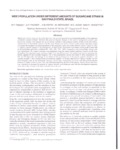Please use this identifier to cite or link to this item:
http://www.alice.cnptia.embrapa.br/alice/handle/doc/919152| Title: | Weed population under different amounts of sugarcane straw in São Paulo State, Brazil. |
| Authors: | RAMOS, N. P.  PACKER, A. P.   VIEIRA, H. B.   MORICONI, W.   ASSIS, M. C. de   ROSSETTO, R.   |
| Affiliation: | NILZA PATRICIA RAMOS, CNPMA; ANA PAULA CONTADOR PACKER, CNPMA; HENRIQUE BARROS VIEIRA, CNPMA; WALDEMORE MORICONI, CNPMA; MARTA CAMARGO DE ASSIS, CNPMA; RAFFAELLA ROSSETTO, APTA. |
| Date Issued: | 2011 |
| Citation: | In: INTERNATIONAL SUGAR CONFERENCE, 4., 2011. Nova Delhi. Balancing sugar and energy production in developing countries: sustainable technologies and marketing strategies. Proceedings... Nova Delhi: IAPSIT, 2011. p. 127-129. |
| Description: | Abstract: Maintenance of the straws on the soil surface has been proved essential for environrnental quality of the sugarcane productive system in Brazil. However, this practice requires changes in the current management systems used around the country. This requires the use of tolerant varieties to the presence of straw residue on the soil surface, improvement in fertilization process, and also pest, disease and weeds control. In this context, this study aimed to evaluate the incidence of weed populations in the sugarcane cultivation under different levels of straw, in order to support possible changes in the management of these plants. Treatments were based on five levels of straw left on the soil surface at harvest, as follows: 0% - 25% - 50% - 75% - 100%, arranged in a randomized block design with four replications. The weeds evaluation was performed using the square method randomly thrown on the floor throughout the experiment area, reaching a total of ten samples per plot. This method was used to determine the density (plants/m2) and absolute frequency (%) of the predominant species individuais in three assessments (34, 106 and 177 days after harvesting). It was observed the predominance of the species Cyperus rotundus L. and Cynodon dactylon L. Pers. independently of treatments applied. At 34 days after harvest Cyperus rotundus was the more frequent weed in the treatments with low and no straw respectively, however with 106 pos-harvests the presence of higher levels of straw (75% and 100%) privileged the growth of this species. Results shown that there was a tendency to increase the number of Cyperus rotundus individuais per area with the development sugarcane cycle, due to the increase in the layer of straw left on the soil. |
| Thesagro: | Palha Praga de planta |
| NAL Thesaurus: | Sugarcane Straw Soil conservation weeds |
| Keywords: | Agricultural residue Sugarcane straw Cana-de-açúcar |
| Type of Material: | Artigo em anais e proceedings |
| Access: | openAccess |
| Appears in Collections: | Artigo em anais de congresso (CNPMA)  |
Files in This Item:
| File | Description | Size | Format | |
|---|---|---|---|---|
| 2011AA77.pdf | 2.42 MB | Adobe PDF |  View/Open |









